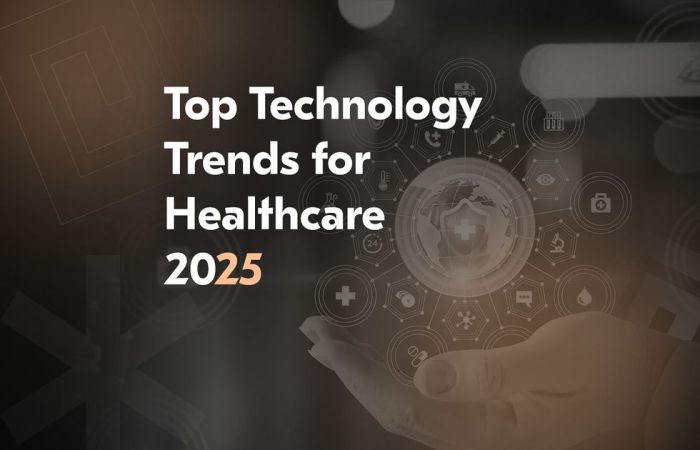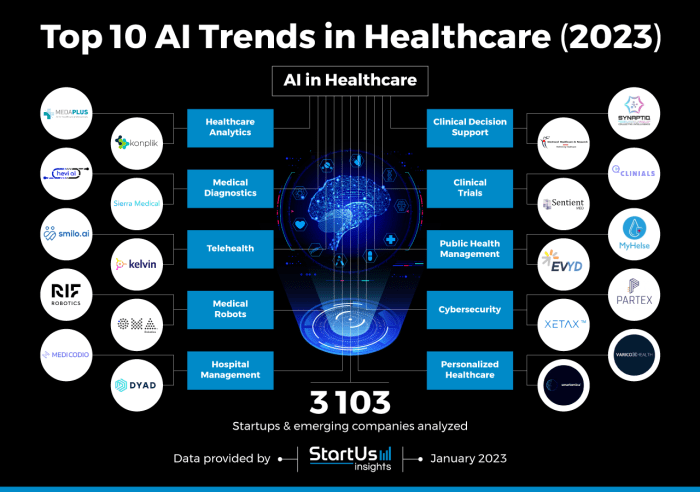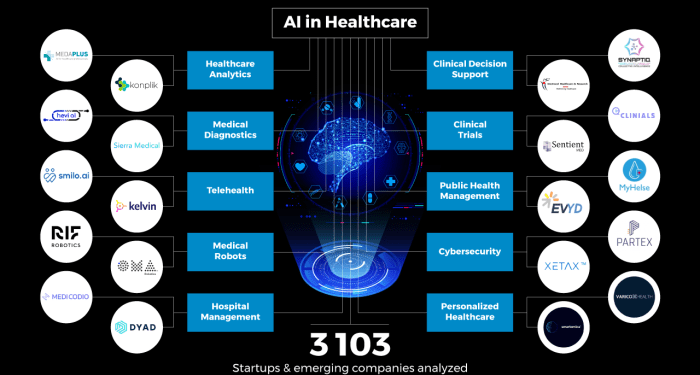As Top 10 health tech innovations to watch in 2025 takes center stage, this opening passage beckons readers into a world crafted with good knowledge, ensuring a reading experience that is both absorbing and distinctly original. The landscape of healthcare is rapidly evolving, with groundbreaking technologies poised to transform patient care and outcomes.
Overview of Health Tech Innovations
Health tech innovations are continuously shaping the future of healthcare by introducing cutting-edge solutions to improve patient outcomes and revolutionize the way medical services are delivered. Here are the top 10 health tech innovations to watch in 2025:
1. Artificial Intelligence in Diagnostics
Artificial intelligence algorithms are being increasingly used to analyze medical images, pathology slides, and genetic data, leading to more accurate and timely diagnoses.
2. Telemedicine and Remote Monitoring
Telemedicine platforms and remote monitoring devices enable patients to receive medical care and consultations from the comfort of their homes, improving access to healthcare services and reducing the burden on healthcare facilities.
3. Wearable Health Tech
Wearable devices that track vital signs, activity levels, and other health metrics in real-time provide valuable data for personalized healthcare interventions and early detection of health issues.
4. Virtual Reality in Therapy
Virtual reality technology is being used to create immersive therapy experiences for mental health conditions, pain management, and rehabilitation, offering innovative treatment options for patients.
5. Robotics in Surgery
Robotic surgical systems enhance precision, dexterity, and efficiency in surgical procedures, leading to better surgical outcomes, shorter recovery times, and reduced complications.
6. Genomic Medicine
Advancements in genomic medicine allow for personalized treatment plans based on an individual's genetic makeup, leading to more targeted therapies and improved patient responses.
7. Blockchain in Healthcare
Blockchain technology ensures secure and transparent sharing of medical data among healthcare providers, patients, and researchers, enhancing data privacy and interoperability in healthcare systems.
8. 3D Printing in Healthcare
3D printing technology is used to create customized implants, prosthetics, and medical devices, offering cost-effective solutions and personalized treatment options for patients.
9. Nanotechnology in Drug Delivery
Nanotechnology enables targeted drug delivery systems that improve drug efficacy, reduce side effects, and enhance patient compliance with treatment regimens.
10. Health Apps and Digital Therapeutics
Mobile health apps and digital therapeutics provide accessible tools for self-management of chronic conditions, behavioral health support, and preventive care, empowering patients to take control of their health.
Artificial Intelligence in Healthcare

Artificial Intelligence (AI) plays a crucial role in transforming the healthcare industry, revolutionizing the way we approach diagnosis, treatment, and patient care. By leveraging AI technology, healthcare providers can offer more personalized and efficient services, ultimately improving patient outcomes.
AI in Personalized Medicine and Treatment Plans
AI has the ability to analyze vast amounts of patient data, including genetic information, medical history, and lifestyle factors, to create personalized treatment plans. By identifying patterns and correlations within this data, AI can help healthcare professionals tailor treatments to individual patients, maximizing effectiveness and minimizing side effects.
Improving Diagnostic Accuracy and Patient Monitoring
AI-powered diagnostic tools can analyze medical images, lab results, and other patient data with incredible speed and accuracy. This not only helps healthcare providers make faster and more accurate diagnoses but also enables continuous monitoring of patients' health status. AI algorithms can detect subtle changes in patient data that may indicate the onset of a condition or the need for intervention, allowing for proactive and personalized care.
Wearable Health Tech Devices
Wearable health tech devices have seen significant advancements in recent years, revolutionizing the way we approach healthcare. These devices are not only convenient but also offer valuable insights into our health and well-being.
Latest Advancements in Wearable Health Tech Devices
Wearable health tech devices now come equipped with advanced sensors that can track various health metrics such as heart rate, blood pressure, sleep patterns, and activity levels. They can also detect irregularities and alert users or healthcare providers in real-time.
Transforming Remote Patient Monitoring
These devices have transformed remote patient monitoring by allowing healthcare professionals to continuously monitor patients outside of traditional clinical settings. This enables early detection of health issues, timely interventions, and personalized treatment plans.
Potential Benefits of Wearable Devices in Promoting Proactive Healthcare
The potential benefits of wearable devices in promoting proactive healthcare are immense. By providing users with real-time data about their health, these devices empower individuals to take control of their well-being. They encourage preventive measures, early intervention, and overall healthier lifestyle choices.
Telemedicine and Virtual Care
Telemedicine and virtual care platforms have seen significant growth in recent years, revolutionizing the way healthcare services are delivered. By leveraging technology, these platforms enable patients to connect with healthcare professionals remotely, breaking down barriers to access and improving convenience.
Enhancing Access to Healthcare Services
- Telemedicine allows patients in remote or underserved areas to receive medical consultations without the need to travel long distances.
- Virtual care platforms offer 24/7 access to healthcare professionals, reducing wait times for appointments and emergency care.
- Patients with mobility issues or disabilities can easily access healthcare services from the comfort of their homes through telemedicine.
Impact on Healthcare Accessibility and Convenience
- Virtual care eliminates the need for in-person visits, making healthcare more accessible to individuals with busy schedules or transportation challenges.
- Telemedicine appointments save time for both patients and healthcare providers, leading to more efficient care delivery.
- Remote monitoring through telemedicine devices allows for proactive healthcare management, reducing the need for frequent hospital visits.
Robotics in Healthcare
Robotics in healthcare have brought about significant advancements in surgical procedures, rehabilitation, and overall healthcare delivery. The use of robots in the medical field has shown great promise in improving precision, outcomes, and patient care.
Use of Robotics in Surgical Procedures
- Robotic surgical systems allow for minimally invasive procedures with enhanced precision and control.
- Surgeons can perform complex operations with more accuracy, reducing the risk of complications.
- Robotics enable access to hard-to-reach areas within the body, leading to improved surgical outcomes.
Robotics in Rehabilitation
- Robotic exoskeletons are used in physical therapy to assist patients in regaining mobility and strength.
- These devices provide targeted support and feedback to help individuals recover from injuries or surgeries.
- Robotics in rehabilitation offer personalized treatment plans and track progress more accurately.
Potential for Robotics to Revolutionize Healthcare Delivery
- Robots can automate repetitive tasks, freeing up healthcare professionals to focus on patient care.
- Telepresence robots enable remote patient monitoring and consultations, expanding access to healthcare services.
- Artificial intelligence integrated with robotics can analyze vast amounts of data to improve diagnosis and treatment planning.
Blockchain Technology in Healthcare
Blockchain technology is revolutionizing the healthcare industry by providing a secure and efficient way to store and share sensitive patient data. It involves a decentralized and tamper-proof digital ledger that records transactions across a network of computers.
Benefits of Blockchain in Healthcare
- Enhanced Security: Blockchain ensures that patient data is encrypted and secure, protecting it from unauthorized access or tampering.
- Interoperability: By enabling secure data exchange between healthcare providers, blockchain promotes seamless interoperability and improves patient care coordination.
- Data Privacy: Patients have greater control over their data through blockchain, allowing them to share information with healthcare providers on a need-to-know basis.
Potential of Blockchain in Healthcare Operations
- Streamlined Processes: Blockchain technology can automate administrative tasks, such as billing and claims processing, leading to cost savings and operational efficiency.
- Enhanced Data Integrity: The immutability of blockchain ensures the accuracy and trustworthiness of medical records, reducing errors and improving patient outcomes.
- Improved Supply Chain Management: By tracking the provenance of pharmaceuticals and medical devices, blockchain can help prevent counterfeit products and ensure quality control.
3D Printing in Medicine
D printing technology has revolutionized the field of medicine by allowing the creation of customized medical devices, prosthetics, and implants with unprecedented precision and efficiency. This innovative technology has the potential to significantly impact healthcare costs and improve patient outcomes.
Applications of 3D Printing in Medicine
- Customized Medical Devices: 3D printing enables the production of personalized medical devices tailored to the specific needs of individual patients, such as hearing aids, dental implants, and orthopedic implants.
- Prosthetics and Implants: 3D printing has transformed the production of prosthetic limbs and implants by offering customized solutions that are more comfortable, functional, and durable than traditional options.
Impact of 3D Printing on Healthcare Costs and Patient Outcomes
- Cost Reduction: By streamlining the production process and reducing material waste, 3D printing has the potential to lower healthcare costs associated with manufacturing medical devices and implants.
- Improved Patient Outcomes: The ability to create personalized medical solutions through 3D printing can lead to better treatment outcomes, increased patient satisfaction, and faster recovery times.
Personalized Medicine
Personalized medicine is a groundbreaking approach that tailors medical treatment to individual characteristics, such as genetics, lifestyle, and environment. By utilizing advanced technologies, personalized medicine aims to provide more effective and targeted healthcare solutions for patients.
Genetic Testing and Precision Therapies
Genetic testing plays a crucial role in personalized medicine by analyzing an individual's unique genetic makeup to identify potential risks or diseases. With this information, healthcare providers can develop precision therapies that are specifically designed to target the underlying causes of a patient's condition.
Potential for Disease Management
Personalized medicine has the potential to revolutionize disease management by shifting the focus from a one-size-fits-all approach to tailored interventions that consider each patient's specific needs. This approach can lead to improved treatment outcomes, reduced side effects, and overall better quality of care for patients.
Internet of Medical Things (IoMT)
The Internet of Medical Things (IoMT) refers to a network of medical devices and applications that connect to healthcare IT systems through online computer networks. This interconnected system of devices and software enables healthcare providers to collect, analyze, and share data in real-time, leading to more efficient and personalized patient care.
Integration of IoMT devices in healthcare systems
IoMT devices are seamlessly integrated into healthcare systems, allowing for continuous monitoring of patients both in clinical settings and at home. These devices can range from wearable sensors that track vital signs to smart medication dispensers that remind patients to take their medication.
Enhancing real-time patient monitoring and data analytics
By providing real-time data on patients' health status, IoMT devices enable healthcare providers to monitor patients remotely and intervene quickly when necessary. The data collected from these devices can also be analyzed using advanced analytics tools to identify trends, predict outcomes, and improve treatment plans.
Potential benefits of IoMT in improving clinical decision-making and patient outcomes
The use of IoMT technology has the potential to revolutionize healthcare by improving clinical decision-making processes and ultimately enhancing patient outcomes. By providing healthcare providers with access to real-time data, IoMT devices can help in early detection of health issues, personalized treatment plans, and proactive interventions, leading to better outcomes for patients.
Augmented Reality and Virtual Reality in Healthcare

Augmented Reality (AR) and Virtual Reality (VR) are revolutionizing the healthcare industry by providing innovative solutions for medical training, patient education, surgical planning, simulation, patient engagement, and treatment adherence.
Applications of AR and VR in Medical Training and Patient Education
AR and VR technologies are being utilized in medical training to create realistic simulations for students and healthcare professionals. These immersive experiences help in understanding complex medical procedures, anatomy, and patient interactions. In patient education, AR and VR enable individuals to visualize their conditions, treatment options, and outcomes, leading to better-informed decisions about their health.
Enhancing Surgical Planning and Simulation
AR and VR play a crucial role in surgical planning by allowing surgeons to practice procedures in a virtual environment before performing them on actual patients. These technologies provide a 3D visualization of the patient's anatomy, helping surgeons to plan the surgery more accurately and reduce risks.
In addition, VR simulations help in training surgeons for complex or rare procedures, improving their skills and confidence.
Potential for AR and VR to Improve Patient Engagement and Treatment Adherence
AR and VR applications can enhance patient engagement by providing interactive experiences that educate and motivate individuals to take an active role in managing their health. These technologies can also improve treatment adherence by offering personalized interventions, reminders, and monitoring tools.
By making healthcare more engaging and accessible, AR and VR contribute to better patient outcomes and overall satisfaction.
Ending Remarks
In conclusion, the Top 10 health tech innovations to watch in 2025 hold immense promise for revolutionizing the healthcare industry. From AI and wearable devices to blockchain and personalized medicine, these innovations are paving the way for a future where healthcare is more accessible, efficient, and patient-centric.
Stay tuned as we witness the incredible advancements that lie ahead in the realm of health technology.
General Inquiries
What are the potential benefits of wearable devices in promoting proactive healthcare?
Wearable devices offer continuous health monitoring, early detection of health issues, and personalized feedback, empowering individuals to take proactive steps towards their well-being.
How is blockchain technology enhancing data privacy in healthcare?
Blockchain ensures secure and immutable storage of patient data, reducing the risk of data breaches and unauthorized access, thereby enhancing data privacy in healthcare.
What role does personalized medicine play in revolutionizing disease management?
Personalized medicine tailors treatment plans based on an individual's genetic makeup, increasing treatment efficacy, reducing side effects, and transforming the management of various diseases.














